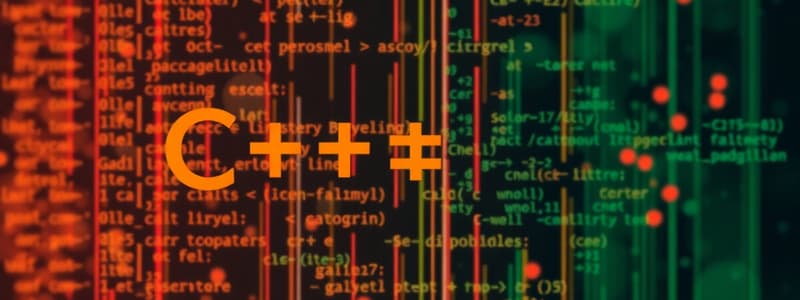Podcast
Questions and Answers
What is a primary goal of algorithm design?
What is a primary goal of algorithm design?
- To solely focus on user interface design
- To solve a problem incorrectly to understand potential pitfalls
- To create complex and detailed code
- To solve a problem efficiently and correctly (correct)
Which of the following best represents a computer formula compared to a mathematical formula?
Which of the following best represents a computer formula compared to a mathematical formula?
- It must account for data types and order of operations (correct)
- It only needs to consider the final output
- It is less detailed than mathematical formulas
- It requires the use of specific programming language syntax
What is the purpose of pseudocode in the context of algorithm design?
What is the purpose of pseudocode in the context of algorithm design?
- To create an executable program directly
- To illustrate program functionality in strict coding language syntax
- To substitute for thorough documentation
- To provide a clear, informal description without strict syntax (correct)
Which step is essential in the problem-solving process after developing a program solution?
Which step is essential in the problem-solving process after developing a program solution?
What does keeping the design simple primarily aim to achieve?
What does keeping the design simple primarily aim to achieve?
Flashcards
Algorithm Design
Algorithm Design
A step-by-step set of instructions to solve a problem correctly and efficiently
Design Considerations: Keep it Simple
Design Considerations: Keep it Simple
Focus on clear, concise, readily understandable design solutions.
Flowcharts
Flowcharts
Visual representations of sequential steps in a process
Pseudocode
Pseudocode
Signup and view all the flashcards
Test Cases
Test Cases
Signup and view all the flashcards
Study Notes
Course Information
- Course name: CSC 1060 Computer Systems & Problem Solving
- Course website: https://xkcd.com/1319/
Objectives
- Understand computer basics, programs, and operating systems
- Describe the history of C++
- Understand the software development lifecycle
- Know programming style and documentation
- Apply coding standards to a program for conventional programming style
- Insert comments to explain code sections
- Write a C++ program
Agenda: Week 01
- Digital Information
- Computers
- Computer Numbering Systems
- ASCII & Lexicographical Order
- History of C++
- Intro to C++
- C++ Program Execution
- TODO
- Resources for Help
Computer Numbering Systems
- Decimal: Base 10, uses digits 0-9, Example: 240
- Binary: Base 2, uses digits 0 and 1, Example: 11110000
- Hexadecimal: Base 16, uses digits 0-9 and letters A-F, Example: 0x7F
1 Byte of Memory
- 1 byte = 8 bits = 2 hexadecimal digits
- Decimal: 0 to 255
- Binary: 00000000 to 11111111
- Hexadecimal: 0x00 to 0xFF
Computer Architecture
- Input (Take input)
- Process (Process information)
- Storage (Store information)
- Output (Output results)
Converting Numbering Systems
- Example conversion from decimal to binary, binary to decimal and hexadecimal, and hexadecimal to decimal.
Converting 243 Decimal to Binary
- Show step-by-step calculations
Converting Hexadecimal to Decimal
- Show step-by-step calculations
C++ Coding
- General guidelines for coding practice style.
Additional Resources
- Khan Academy lessons (digital information, computers): Provide specific links
- Additional tutorials or documents for help: Supply links
Problem Solving
- Solve 2 coding problems, don't look at the solutions until after attempt
- Complete 5 practice questions in a self-assessment
Problem: Converting Fahrenheit to Celsius
- Identify the inputs (Fahrenheit)
- Identify the outputs (Celsius)
- Create examples (e.g., Fahrenheit: 32, Output Celsius:)
Problem #1: Fair Pass Cost
- A single fair ticket costs $8.
- A family pass costs $25 more than half of the ticket.
- Calculate the cost of the family pass.
History of C++
- 1979: C with Classes
- 1985: First commercially released version of C++
- 1998: ISO/ANSI C++98 First standardization
- 2011: ISO/ANSI C++11
- 2014: ISO/ANSI C++14
- 2017: ISO/ANSI C++17
- 2020: ISO/ANSI C++20
- 2023: Next major revision
Development Considerations
- Initial Development: Programming language, Clarity of Design, Programming Time, Debugging/Testing Time, Speed of Execution, Size of program and data
- Maintenance: Flexibility, expandability, portability, clarity of code, documentation
Coding Standards in C++
- Use of comments, appropriate coding style, namespace usage guidelines
C++ Rules and Standards
- C++ symbols like { }
- main function
- case-sensitivity
- data types, and other essential coding rules.
Comments
- Comments are documentation
- Do NOT re-state the instruction, describe the meaning and algorithm.
C++ Program
- Include
- Input / output - int main () {
- Display Hello World and C++ message
- Return 0
C++ Program Execution Process
- Different steps involving the editor, preprocessor, compiler, linker
Pre-work Grade
- Post weekly discussion questions
- Complete week 02 module in D2L 100%
Help / Office Hours
- Student office hours, by appointment and drop-in via Zoom
- Email address for questions
- On-campus tutoring information
- 24/7 online tutoring through D2L
Studying That Suits You
Use AI to generate personalized quizzes and flashcards to suit your learning preferences.
Related Documents
Description
This quiz covers the fundamental concepts of computer systems and problem solving as outlined in Week 01 of CSC 1060. Topics include digital information, computer numbering systems, and an introduction to C++. Test your knowledge on ASCII, C++ program execution, and the history of C++.




